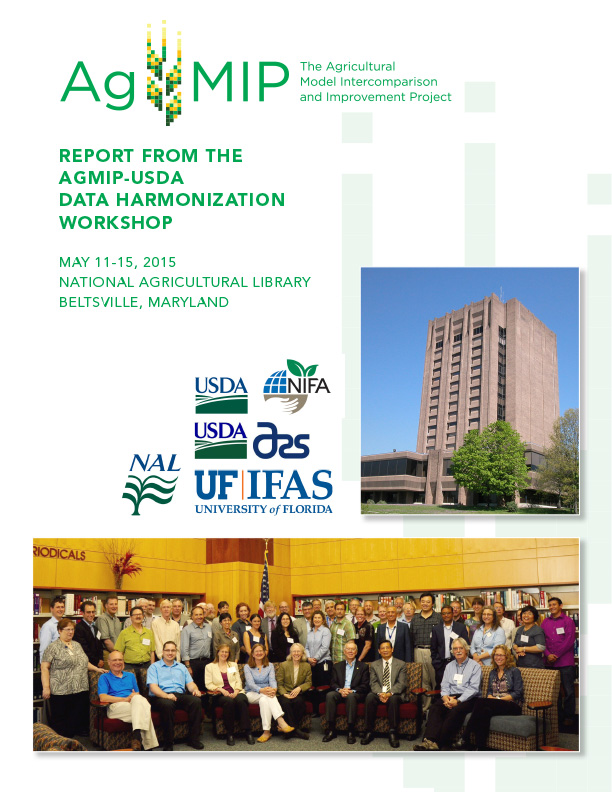AgMIP-USDA Data Harmonization Workshop
Jun 3, 2015
By: Shari Lifson
There is a major gap between the potential value of data collected in agricultural experiments and the value currently obtained through use of those data. Typically, data collected in experiments are used for the original purpose, and papers and reports are written to address research questions that were used to justify the experiments. Vastly greater value might be obtained if the data were combined across locations, time, and management conditions so that one could develop or evaluate models that could help inform decision support systems, assess the benefits of new technologies or management, changes in climate, and tradeoffs between productivity gains and environmental risks.
May 11-15 an AgMIP-USDA joint workshop was held, sponsored by the National Institute of Food and Agriculture (NIFA), at the National Agricultural Library to understand how to harmonize agricultural data collected from sites across the USA, demonstrate how a National Agricultural Data Network might work, develop ideas for a roadmap on how to create such a network, and make recommendations to the USDA (ARS and NIFA) for developing an operational data network. 55 participants from across the US who are involved in various USDA-supported research efforts attended.
There is increasing use of crop, livestock, and forestry models in research on climate change, food security, nutrient management, and other major issues. They are used to address broad policy questions such as “what is the vulnerability of the US food and fiber system to climate extremes and change”, and “can sustainable intensification with improved varieties and nutrient and water management lead to increased production needed to feed over 9 billion people by midcentury?” Crop models, for example, use similar input data on soils, weather, and management; however, those models have been developed by different research groups and use different data formats and units.
Because of its emphasis on using multiple models in intercomparison, improvement, and assessment efforts, the Agricultural Model Intercomparison and Improvement Project (AgMIP) has developed novel, efficient methods for harmonizing inputs by translating them for input to each given model in a way that the model input code does not need to be changed.
The May workshop was built on a one-day workshop that was held previously at the University of Florida on January 10, 2014, to explore concepts for harmonizing agricultural databases and models being developed and used by various USDA research projects and by AgMIP. Participants in that workshop included researchers and leaders from many of the USDA-NIFA funded research projects, several USDA-ARS labs, and the National Agricultural Library (NAL).
You can see the summary presentations made by each of the breakout groups on Friday morning at 11:30 am, May 15 at the following link:
https://www.youtube.com/watch?v=Dyh7TfzsjGs
A report summarizing the accomplishments and recommendations from the most recent May workshop is available here. Highlights of the report include:
- The workshop created a database node at the NAL based on the AgMIP approach and demonstrated that crop data from various projects can be successfully uploaded, then discovered, viewed, downloaded, and used for crop model and other types of analyses. Data for seven research studies from six locations (Idaho, Arizona, Iowa, Michigan, Maryland, Vermont) are now on the NAL data node (see map in the full report).
- The workshop developed initial design of metadata and data dictionary for livestock research projects. In particular, considerable progress was made on dairy data.
- Also initial ideas were developed for compatible data for life cycle analysis (LCA) studies.
- The workshop also successfully connected the new data node to the NAL’s Ag Data Commons, showing complementarity and benefits of having the main portal data node for a National Agricultural Data Network (NADL) housed at the NAL.
- Guiding principles were drafted for implementation and management of a NADL – see attached report.
- A Roadmap for development of the NADN was developed by participants, with a timeframe of about 3 to 5 years for full deployment – see report.
- Recommendations were also written with the goal of getting started soon, with the NAL playing a central role and with the broader AgMIP community contributing to the scaling up of what was started during this workshop.

